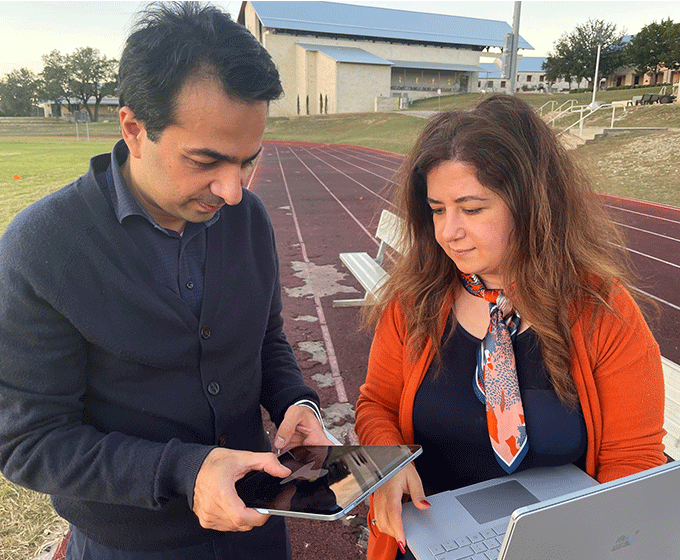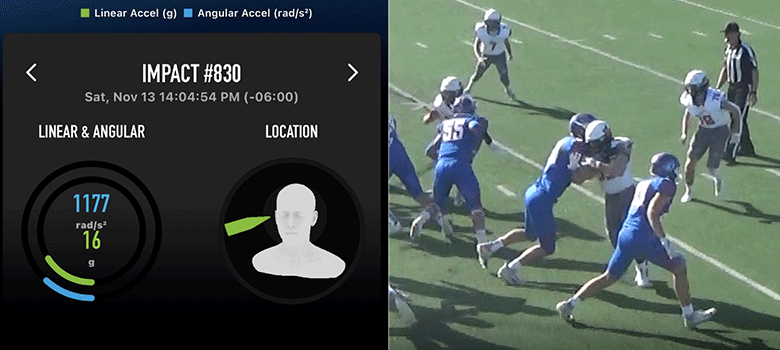
Morteza Seidi (left) and Marzieh Hajiaghamemar (right), assistant professors in the UTSA Department of Biomedical Engineering, are leading an innovative research project to more accurately detect concussions in football players.
NOVEMBER 16, 2021 — Football players at a local high school are benefitting from innovative concussion research developed by the UTSA College of Engineering and Integrated Design. With expertise in concussion and helmet design, assistant professor Marzieh Hajiaghamemar and assistant professor of research Morteza Seidi of the UTSA Department of Biomedical Engineering are combining their knowledge to come up with an innovative approach to better understand, detect and protect players from concussions.
“Traumatic brain injury happens a lot, but there still aren’t any techniques that assess and monitor the risk of concussions in a timely manner or helmet designs that effectively mitigate them. That led us to want to learn more about what happens inside the brain,” said Hajiaghamemar, the principal investigator.
Their novel concussion detection approach involves three steps: researchers collect data from football players; a proprietary computer model analyzes the information; and biomarker testing measures elevated protein levels that occur with concussion-level brain trauma.

Head impact data from the TMI Episcopal High School football team (in white jerseys) was assessed by UTSA researchers after every game and practice. High-tech mouthguards provided linear and angular head impact data (left) which was verified through video recordings (right).
“What we are trying to accomplish is to set up a regular assessment battery—using head impact data—with our tissue deformation modeling and biomarker testing, so the players can be monitored all the time, during the game and after the game, for risk of concussion,” Hajiaghamemar added. “I’m not aware of any research combining these three elements, along with a unique data model to interpret the results.”
To test the theory, they partnered with the football team at TMI Episcopal High School in northwest San Antonio. Before every game and practice, biomedical engineering students James Wallace and Sammy Elashy manage and distribute high-tech mouthguards to football players participating in the program to collect and analyze the head kinematic data. The mouthguards, designed by a third-party vendor, contain a set of gyroscope and accelerometer sensors that transmits head impact data via Bluetooth to a computer on the sidelines.
Wallace and Elashy also record practices and games on video for additional impact data. Part of the job includes checking video to confirm whether the head impact biomechanics captured by the mouthguard sensors are from a real impact.
“The video we record is an additional step to confirm concussion readings,” Elashy said. “Sometimes there are false readings due to players chewing on their mouthguard too hard.”
Seidi, who is also a helmet-design expert, says the ability to identify head injuries as they happen is one of the major benefits to players and their families that will result from this study.
“In many cases, concussions go unreported because the athlete doesn’t realize the extent of their head impact. They may not have any severe clinical symptoms to notice or they don’t want to be pulled from the game,” Seidi explained. “Identifying head injuries in real time, during a game, will give trainers the scientific data to use with existing concussion protocols to protect players from further injury.”
“I played football when I was in high school,” Wallace added. “Being involved in this research project, I’m sure I had a few concussions but didn’t realize it.”
The mouthguard sensors measure two types of kinematics, or head impacts, called head linear and angular motions. The mouthguard data is transmitted to a laptop on the sideline that features a computer model to assess concussion risk. The model incorporates available peak angular velocity (PAV) data from studies on pigs and data from the National Football League.
The PAV data tracks spin and rotational movement of the brain during a head collision. The computer model is programmed with established biomechanical loadings on amounts of brain deformation the player can tolerate. The readings take place in real time and are visualized like a bar graph. The trainer and coach are notified when any reading goes above the acceptable brain deformation load.
The third step in the concussion detection process is biomarker testing through a blood sample. The biomarker test determines if elevated spike protein levels exist in the blood which occurs from brain trauma. David Zhang, a biomedical engineering graduate student, collects and analyzes the blood samples before and after playing football and whenever players receive a concussive head impact to analyze the brain damage biomarkers in the blood.
The trainers and coaches can get daily data to track impact levels to identify trends with players, positions or certain practices or games. This helps coaches teach and reinforce tackling techniques to minimize the severity of head impacts. Of the 21 players part of the program, two got concussions during the season.
“During a particular game, one player had higher brain loads than his average during other games,” Hajiaghamemar said. “I asked the physical trainer about it, and he said that game was against a rival, so it’s interesting to see how certain conditions can increase levels of head impact.”
TMI finished its football season on November 13. The UTSA concussion team will spend its offseason evaluating all the data. An area of focus is analyzing players with repeated sub-concussive head impacts. They will study how their brain-related biomarkers were altered due to one season of repeated head exposures, especially for the more aggressive players.
One area they want to advance is how to replace the blood sample for biomarker testing with a noninvasive option. They also want to take their research to a bigger league.
“We appreciate the TMI football team giving us the opportunity to refine our concussion testing process. It was a positive experience for everyone,” Hajiaghamemar said. “Now we’re very interested in working with the UTSA Roadrunners football team. Measuring concussion impacts with college athletes would provide valuable data to progress our research.”
UTSA Today is produced by University Communications and Marketing, the official news source of The University of Texas at San Antonio. Send your feedback to news@utsa.edu. Keep up-to-date on UTSA news by visiting UTSA Today. Connect with UTSA online at Facebook, Twitter, Youtube and Instagram.
Move In To COLFA is strongly recommended for new students in COLFA. It gives you the chance to learn about the Student Success Center, campus resources and meet new friends!
Academic Classroom: Lecture Hall (MH 2.01.10,) McKinney Humanities BldgWe invite you to join us for Birds Up! Downtown, an exciting welcome back event designed to connect students with the different departments at the Downtown Campus. Students will have the opportunity to learn about some of the departments on campus, gain access to different resources, and collect some giveaways!
Bill Miller PlazaCome and celebrate this year's homecoming at the Downtown Campus with food, games, giveaways, music, and more. We look forward to seeing your Roadrunner Spirit!
Bill Miller PlazaThe University of Texas at San Antonio is dedicated to the advancement of knowledge through research and discovery, teaching and learning, community engagement and public service. As an institution of access and excellence, UTSA embraces multicultural traditions and serves as a center for intellectual and creative resources as well as a catalyst for socioeconomic development and the commercialization of intellectual property - for Texas, the nation and the world.
To be a premier public research university, providing access to educational excellence and preparing citizen leaders for the global environment.
We encourage an environment of dialogue and discovery, where integrity, excellence, respect, collaboration and innovation are fostered.